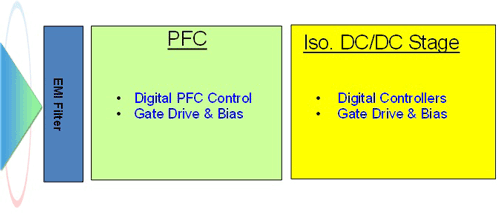What is digital power? Unfortunately, there are too many definitions, but the best I have found is applying “digital control” techniques using a microcontroller or digital signal processor. This means, that for the dc/dc stage, the regulator portion samples feedback information using an analog-to-digital converter and closes the feedback loop numerically. Digital power also means ‘inherent’ monitoring and management of the power converter(s) which make up part of the design in both an ac/dc power factor correction (PFC) stage and an isolated dc/dc power-supply stage. The microcontroller provides the pulse width modulation (PWM) techniques to construct the control effort in the form of PWM duty ratio(s) as one of its key functions.
Digital power is not a new concept by any means. Engineers have used microcontrollers or digital signal processors in their power supplies for more than three decades for communications, power sequencing, soft-start and topology control. In today’s world, digital power is far more highly integrated than it was in the past employing more sophisticated algorithms. See Figure.

Figure: The microcontroller is what differentiates between a digital power system and a conventional analog power system.
Now is the time for designers to get a firm grasp of the basic fundamentals of digital power so that the advanced features of the latest digital power solutions can be properly used to greatly enhance their power-supply designs.
Where does one go to find some good tutorials? I’m glad you asked.
Note: Analog designers, take heart! The following articles are five of the best articles that will whet your appetite and enable you to begin designing with digital power. Enjoy!
If you have suggestions for other articles, courses or papers that should be included here, please let us know by e-mailing Electronic Products Feedback .
1: Digital Control for Power Factor Correction
This is an exhaustive and complete thesis that uncovers the secrets of power factor correction (PFC) enhancements by using digital control techniques entitled. PFC is at the heart of improvement in AC/DC power supply designs with the adaptive control capabilities enabled by the latest digital power hardware and “canned” algorithms available in the industry.
2: Digital Pulse-Width Modulation Control in Power Electronic Circuits: Theory and Applications
This second piece will introduce the designer to the basics of a very key area of digital power from the dc/dc, point-of-load perspective. Simply put, the switching regulator design is greatly improved by the fast and accurate high-resolution pulse-width modulation created by the microcontroller. This enables on-the-fly adaptive changes in load conditions virtually in real time.
3: Integrated Digitally Controlled Switched Mode Power Supplies (SMPS) for Portable Applications
Another thesis-based article not only discusses the topic but in addition gives a finely detailed treatment of analog vs. digital controller architectures. In doing so, it provides the analog engineer a good perspective of the analogous nature of digital and analog power.
4: Introduction to MATLAB/Simulink for switched-mode power converters
In our fourth piece, California Electronics Center introduces the designer to simulation techniques for the digital buck converter that will enable a good analysis of the design before implementing it to breadboard form.
5: The Impact of Digital Control in Power Electronics
Finally, the Colorado Power Electronics Center brings together all of the aspects of digital power in a summary of how digital control affects high-frequency SMPS.
Advertisement
Learn more about Electronic Products Magazine





